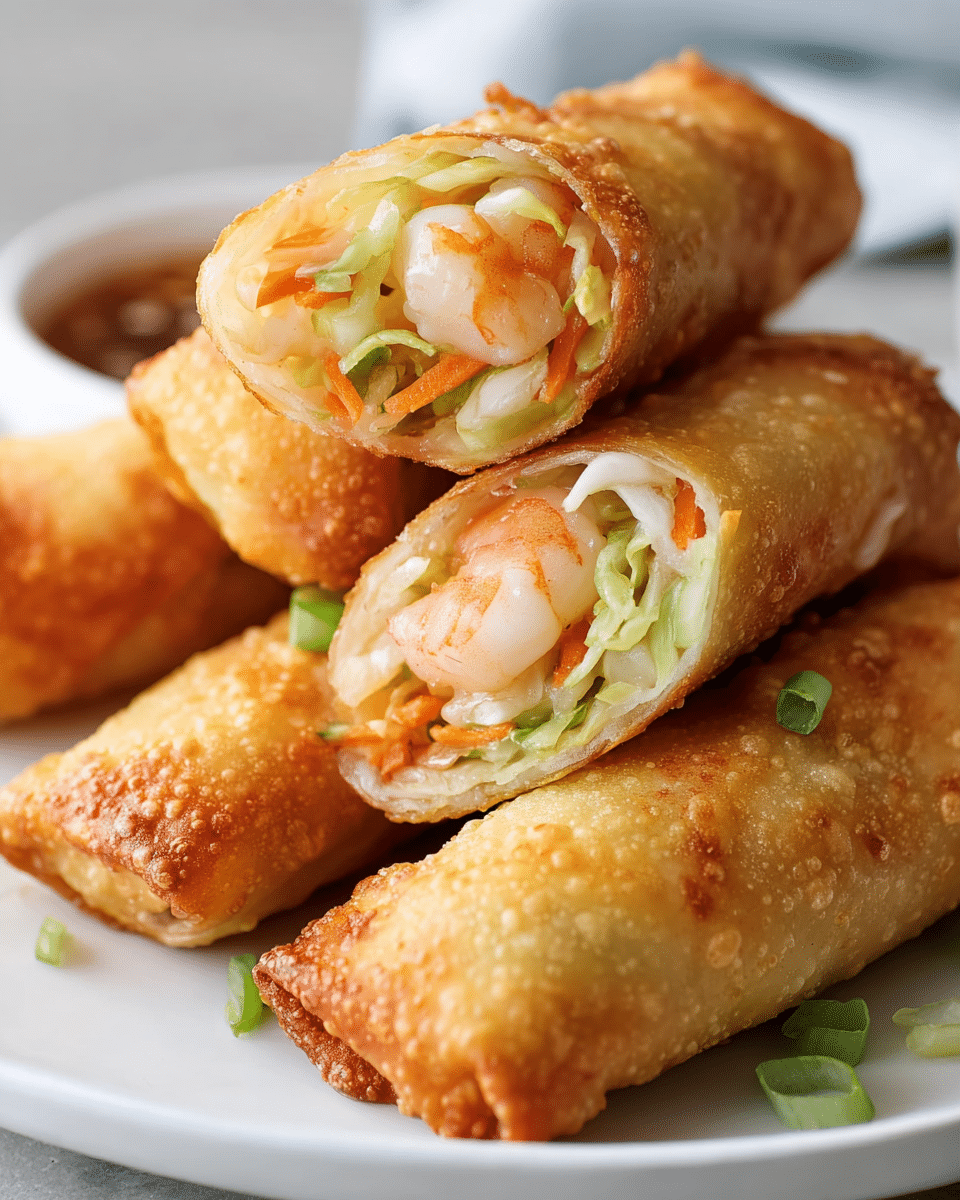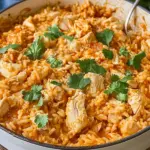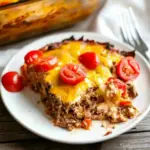The crisp, golden shells of these Shrimp Egg Rolls give way to a juicy and flavorful filling of tender shrimp, cabbage, carrots, and garlic all wrapped up in a handheld snack that’s perfect for dipping. These rolls strike the ideal balance between crunch and savor, making them irresistible for seafood lovers and appetizer enthusiasts alike.
Perfect for entertaining or enjoying as a snack, these egg rolls come together quickly and deliver restaurant-quality results at home. The umami-rich filling is perfectly complemented by dipping sauces like sweet chili or spicy soy, creating a mouthwatering bite every time. Add them to your party menu or serve them up as a family snack these egg rolls never disappoint.
Full Recipe:
Ingredients:
-
1/2 pound medium shrimp, peeled, deveined, and chopped
-
2 cups shredded cabbage
-
1/2 cup shredded carrots
-
2 green onions, thinly sliced
-
2 cloves garlic, minced
-
1 tablespoon ginger, minced
-
2 tablespoons soy sauce
-
1 tablespoon sesame oil
-
1 tablespoon cornstarch
-
10 egg roll wrappers
-
Vegetable oil, for frying
Directions:
-
In a large skillet over medium heat, add sesame oil. Sauté garlic and ginger for 1 minute until fragrant.
-
Add chopped shrimp and cook until pink, about 3–4 minutes.
-
Stir in cabbage, carrots, and green onions. Cook for 2–3 more minutes until vegetables are slightly tender.
-
Add soy sauce and cornstarch, mixing well to coat everything evenly. Cook another 1–2 minutes, then remove from heat. Let the filling cool.
-
Place about 2 tablespoons of the filling in the center of each egg roll wrapper. Roll tightly, folding in the sides, and seal the edges with water.
-
Heat vegetable oil in a large pot to 350°F (175°C).
-
Fry the egg rolls in batches until golden brown and crispy, about 3–4 minutes per side. Drain on paper towels.
-
Serve hot with your favorite dipping sauce, like sweet chili or soy sauce.
Prep Time: 20 minutes | Cooking Time: 15 minutes | Total Time: 35 minutes
Kcal: 210 kcal per roll | Servings: 10 rolls
Crispy, golden, and packed with juicy shrimp and crunchy vegetables, shrimp egg rolls are a celebrated appetizer that bridges tradition and innovation in Asian‑American cuisine. With their bubbly, deep‑fried exterior and savory seafood filling, they offer a satisfying textural contrast and rich flavor profile that makes them a perennial favorite at restaurants, parties, and home kitchens alike.
What began as a Chinese street food and banquet dish evolved in mid‑20th century America into the iconic egg roll familiar today. While versions of spring rolls and similar fried wrappers have existed in Asia for centuries, the American egg roll with its thicker wheat wrapper and bubbly, crunchy crust likely originated in New York City in the 1930s, attributed to chefs like Henry Low or Lum Fong.
Shrimp egg rolls are one of several popular regional and vegetarian variations. Their appeal lies in the light seafood base, which offers sweet, tender bite inside a savory, crisp shell. Unlike heavier pork or chicken fillings, shrimp provide protein without greasiness, delivering flavor and nutrition in every bite.
A Journey Through Origins and Evolution
From Ancient Spring Rolls to American Egg Rolls
The ancestors of egg rolls spring rolls date back to China, where they were served during the Spring Festival as symbols of wealth and renewal. These were usually lighter and thinner than today’s egg rolls, often filled with vegetables and sometimes meat. Over centuries, and with waves of migration, spring rolls morphed and spread across Asia and beyond.
In the U.S., Chinese immigrants adapted the concept for American palates. Chefs like Henry Low published recipes in the 1930s including shrimp, pork, scallions, and mushrooms. Meanwhile, restaurants like Lum Fong’s in New York touted themselves as introducing true Chinese dishes like shrimp rolls and wonton soup to Americans as early as the 1940s and ’50s.
Introducing the Shrimp Filling
Shrimp is a natural pairing for the crispy wrapper. It adds a gentle sweetness and tender texture. In Vietnamese variations known as chả giò cuốn tôm, whole shrimp often with the tail left intact as a handle are coated, rolled, and fried, resulting in elegant, crowd‑pleasing bites.
Meanwhile, Western‑styled shrimp egg rolls typically use chopped shrimp mixed into a medley of shredded vegetables like cabbage, carrots, bean sprouts, and aromatic seasonings like garlic, ginger, and soy sauce. These variations deliver balanced taste and are customizable for dietary preferences.
Nutritional Outlook & Health Considerations
Shrimp egg rolls offer a combination of protein, vegetables, and carbohydrates, making them more nutritionally balanced than many fried snacks. Shrimp is a source of lean protein and provides key nutrients like vitamin B12, selenium, and iodine. Vegetables contribute fiber, vitamins C and K, and antioxidants.
However, method matters. Traditional deep‑frying delivers 200–300 kcal per roll, with 10–15 grams of fat some of which may be saturated or trans fats depending on the oil. By contrast, baked or air‑fried versions cut calories and fat significantly often to around 150–200 kcal and 4–6 grams of fat per roll.
Choosing whole‑grain wrappers or trimming oil where possible can further lighten the dish without sacrificing crunch or flavor.
Why Shrimp Egg Rolls Remain Popular
- Sensory Appeal: The crunch of the wrapper, the tender shrimp inside, and the hint of umami from soy, ginger, or garlic create a memorable experience in each bite.
- Visual Elegance: Shrimp egg rolls often feature a tail tip protruding from the end, adding flair particularly in Vietnamese chả giò. The golden brown exterior and neat packaging make them photogenic and festive.
- Versatility: They pair beautifully with a wide range of dipping sauces tangy sweet chili, soy vinegar, hoisin, spicy mustard, or peanut sauce making them adaptable to many flavor profiles and occasions.
Creative Customizations & Variations
Filling Innovations
- Whole shrimp rolled individually (as in chả giò cuốn tôm) for shrimp-centric bites and visual impact.
- Chopped shrimp mixed with cabbage, carrot, bean sprouts, scallions, ginger, and sesame oil.
- Fusion twist: add crab, fish, tofu, or even diced fruit (pineapple or mango) for texture and sweetness.
Cooking Methods
- Air-fried or baked for lower fat and crispiness.
- Pan-fried in minimal oil for crunch with lighter texture.
- Deep-fried remains classic, offering unbeatable crispness and a golden sheen.
Wrappers & Shapes
- Traditional rectangular wheat‑flour egg roll skins offer sturdy crunch.
- Thinner spring roll wrappers yield a flakier bite.
- Lumpia wrappers (used in Filipino cuisine) produce slender, elongated rolls with extra crispiness.
Dipping Sauces
- Soy‑vinegar garlicky blend, sweet chili sauce, peanut or hoisin‑based dips, spicy mustard, or a Japanese negi‑miso sauce for an umami twist.
Serving Ideas & Occasions
Shrimp egg rolls excel as appetizers serve alongside dim sum, dumplings, or sushi for a multi-course Asian‐inspired spread. They also shine as party finger food when served with dipping sauces on a platter. Pairing them with steamed rice, noodle dishes, or a crisp salad turns them into a satisfying meal.
For lighter presentation, shrimp egg rolls wrapped in butter lettuce leaves and dipped into sauces make an elegant, low-carb twist.
Storage & Make‑Ahead Tips
Shrimp egg rolls can be assembled ahead and stored (uncooked) in airtight containers or wrapped tightly, staying good for a few days in the fridge or up to two months in the freezer. Once cooked, they keep in the fridge for 2–3 days.
To reheat while preserving crunch, avoid microwaves; instead, oven‑reheat at 350 °F for 10 minutes or use an air fryer. If frozen, cook directly from frozen state for best texture retention.
Cultural Context & Global Variants
- American Chinese egg roll: thicker wrapper, cabbage‑pork or shrimp filling, heavy fry classic U.S. take on the Chinese roll.
- Vietnamese chả giò cuốn tôm: often whole shrimp, rice‑paper or wheat wrapper, served with lettuce and herbs, dipped in nước chấm or sweet chili sauce.
- Filipino lumpia Shanghai: similar concept, often pork or shrimp, thinner circular wrapper, elongated shape for bite‑size sharing.
- Other shrimp‑wrapped dishes: Thailand’s kung sarong features battered shrimp wrapped in egg noodles, deep fried and served with chili sauce a different expression of crispy shrimp snack culture
Why Your Readers Will Love It
- Flavor meets texture: every bite combines crispness with tender shrimp sweetness.
- Elegant & shareable: beautiful on the plate; perfect finger food for parties or family meals.
- Adaptable & creative: allows mix‑ins, sauces, cooking methods to suit preferences.
- Accessible cooking: simple preparation; can be made ahead for convenience.
- Nutrition-conscious: shrimp provides lean protein; vegetables add fiber and micronutrients; baking methods reduce fat load.
Conclusion: Shrimp Egg Rolls as a Culinary Classic
Shrimp egg rolls embody the best of fusion cooking rooted in Asian culinary traditions, refined in American kitchens, and made endlessly customizable for modern taste. They deliver a crowd-pleasing mix of textures, flavors, and visual appeal, all while offering nutritional value in a compact package.
Whether deep‑fried golden and indulgent or air‑fried for lighter satisfaction, shrimp egg rolls make a confident statement on any menu be it casual snack, elegant appetizer, or flavorful part of a larger meal. With international roots, customizable fillings, and flexible cooking options, they offer something for every cook and eater.
Invite your readers to explore the shrimp egg roll as both nostalgic favorite and creative canvas one that honors heritage even as it welcomes new interpretations. Each crisp bite is a window into tradition and innovation rolled into one irresistible package.






